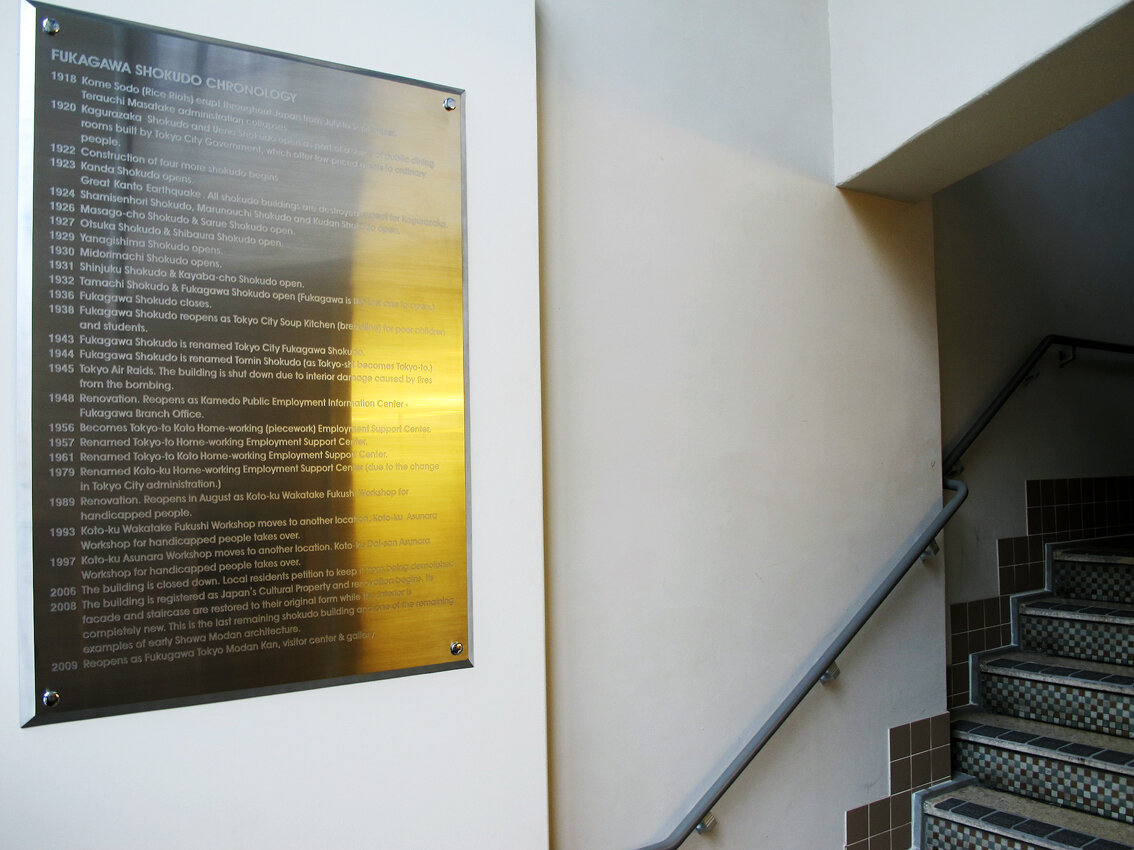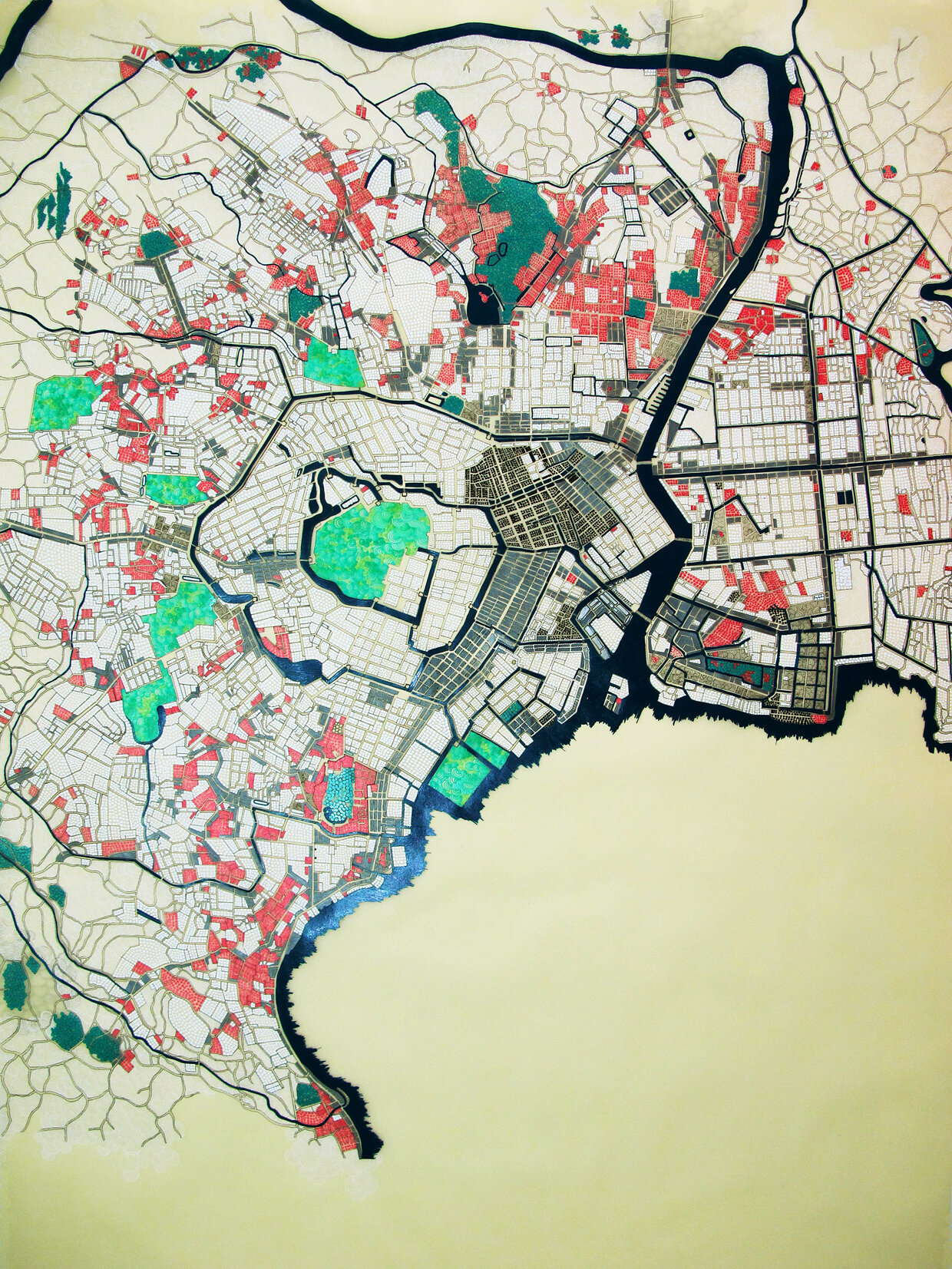
Fukagawa Shokudo | 2010-2011
Opening Performance by off-Nibroll


Fukagawa Shokudo Chronology | 2011 | etching on steel plate | 120 x 84.5 x 2 cm

Text from Chronology


still from Well-side Gatherings

still from Well-side Gatherings: rice stories, the rioters, the speakers and the voyeurs | 2011 | HD, audio | 8:24 mins

Opening performance by off-Nibroll

Kome Sodo: Word Play | 2011 | vinyl decals on tables

12 text panels: Kome Sodo – from wives’ conferences to class conflicts and 1918 mass protests | 2011 | 26 x 19 cm each

Edo Tokyo | 2010-2011 | 110 x 70 cm

Tokyo Urban Planning Map after 1923 Great Kanto Earthquake | 2011 | 100 x 63 cm

US Strategic Bombing Survey of Tokyo 1944-1945 | 2011 | 90 x 64 cm
In the Fukagawa Shokudo (Fukagawa Dining Room) project, Chung approached a traumatized site, in this case, a historic building, and transformed it into a multidimensional stage for exhibition, play, performance,[1] and archive. The Fukagawa Shokudo (today’s Fukagawa Tokyo Modan Kan) is the only surviving building from a series of public dining rooms commissioned by the Tokyo metropolitan government after the 1918 Kome Sōdō (rice riots) and 1923 earthquake. Conducted a comprehensive research into major socio-political and cultural developments in Japanese modern history, Chung’s intervention provided a lens onto the intersections between urban heritage, community activism, and historical change.
To produce an interrelated body of work that was site-specific, in terms of relating to the historical context of the building, as well as the spatial conditions of the structure as an exhibition venue, Chung researched its chronology. Important aspects include its construction as part of early twentieth-century Shōwa Modan (Showa Modern) and as last in the series of shokudo. During the 1945 air raids its interior was destroyed but its external structure survived. Its historical significance and resilience has thus resulted in its current status as National Tangible Cultural Property.
The various components for this project held local relevance, yet also resonated with other global histories. A large stainless steel plaque etched with a chronology of the building and installed facing a series of historical images of the building with little context, its placement thus provides a more complete historical account of the structure. Her map drawings are based on Tokyo’s urban plans at critical historical junctures, as the titles aptly specified. Vinyl decal words and phrases adorned the dining tables are selected from textual accounts and narratives pertaining to the Kome Sōdō; the 12 text panels created with a typewriter are direct excerpts from the book Riots and Citizens: Mass Protest in Imperial Japan by Michael Lawrence Lewis.
The video Well-side Gatherings: rice stories, the rioters, the speakers, and the voyeurs is a dance performance that Chung had directed in collaboration with Arabesque Dance Company, based in Sài Gòn (HCMC), references the origins of the rice riots, when fishermen’s wives in a fishing village in Toyama Prefecture organized a protest in July 1918. The performance alludes to the prominent role played by these women, and their communal discussions in which they debated political and social issues during the food shortages. Chung described how they were, in a sense, the political activists of the period, and such a performance paid tribute to their lesser-known involvement in the events of the time. Yet Well-side Gatherings also serves as a reimagining of a scenario familiar to those who have experienced mass food shortages. For Chung, memories of the 1975-86 subsidy period (thời bao cấp) and the 1978 food shortage played a part in shaping her vision for the piece, in which the dancers forcefully and lyrically grapple over a brick to mark their place in line and fight for a single sack of rice, set against an oral reading of numerical figures from the Kome Sōdō. The performance would later be reinterpreted in a live multi-media theatrical performance directed and choreographed by Chung, titled Chronicles of a Soundless Dream.[2]
[1] The project was partly funded by Art Matters New York and supported by Fukagawa Tokyo Modan Kan Gallery in Japan.
off-Nibroll is a performance, dance, and multi-media group founded by Keisuke Takahashi and Mikuni Yanaihara in 2005.
[2] Presented in September 2012 at Lệ Thanh Theater, Ho Chi Minh City.
Related exhibitions:
Fukagawa Shokudo | Tokyo Modan Kan, Tokyo | 2011
I Bienal del Sur: Pueblos en Resistencia | Caracas, Venezuela | 2015